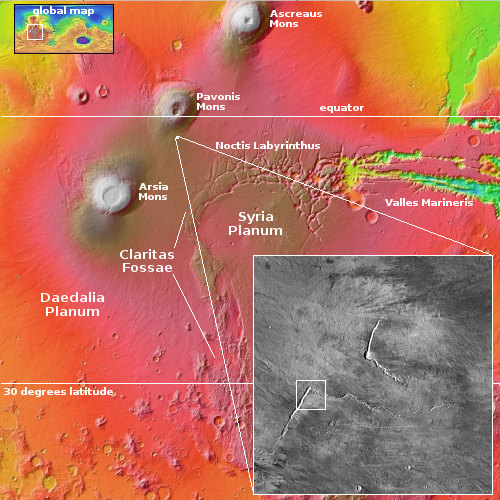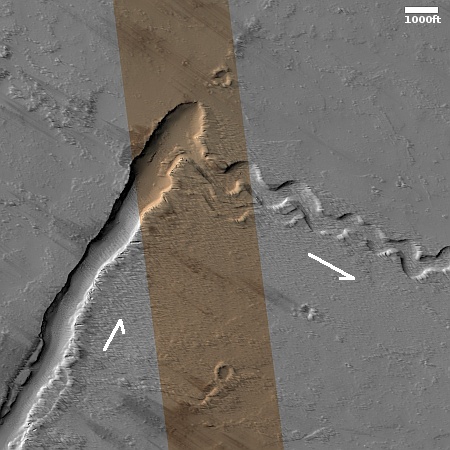Weird drainages on Mars
Cool image time! The picture to the right, cropped, reduced, and sharpened to post here, was taken on Februay 11, 2025 by the high resolution camera on Mars Reconnaissance Orbiter (MRO). The camera team posted it yesterday as their own cool image, labeling it “A Fissure and Channel near Pavonis Mons”. From the caption:
A linear trough strikes northeast, then abruptly ends (or changes into a narrow ridge). Where the trough ends, a sinuous channel has an east-southeast strike, trending at almost a right angle to the trough. What happened to form these features?
We can speculate that first there was a southwest-to-northeast trending fracture or fault, perhaps associated with a volcanic vent. Groundwater (or some other runny fluid) coursed through the fault until overflowing and forming the sinuous channel. Continued movement through the fault carved a trough up to the overflow point.
The arrows indicate the downhill grades. Though this caption mentions groundwater, it is far more likely that the “runny fluid” was lava, as shown by the overview map below.

The white dot on the map to the right marks the location, on the southern flanks of the giant volcano Pavonis Mons. What likely happened is that lava vented out through the southwest-to-northeast fault, and then flowed downhill in this meandering channel. The location, in the dry tropics, reinforces this hypothesis, as this region appears to have little near surface ice.
The inset on the map shows that the meandering channel extends for quite a considerable distance to the east. In fact, it can be traced for almost another 40 miles, dropping 2,000 feet in elevation along the way. Since evidence suggests lava on Mars is less viscous and can flow much faster, almost like water, than on Earth, it is not unreasonable to conclude this channel was carved by lave venting from Pavonis Mons, when it was active more than a billion years ago.
On Christmas Eve 1968 three Americans became the first humans to visit another world. What they did to celebrate was unexpected and profound, and will be remembered throughout all human history. Genesis: the Story of Apollo 8, Robert Zimmerman's classic history of humanity's first journey to another world, tells that story, and it is now available as both an ebook and an audiobook, both with a foreword by Valerie Anders and a new introduction by Robert Zimmerman.
The print edition can be purchased at Amazon or from any other book seller. If you want an autographed copy the price is $60 for the hardback and $45 for the paperback, plus $8 shipping for each. Go here for purchasing details. The ebook is available everywhere for $5.99 (before discount) at amazon, or direct from my ebook publisher, ebookit. If you buy it from ebookit you don't support the big tech companies and the author gets a bigger cut much sooner.
The audiobook is also available at all these vendors, and is also free with a 30-day trial membership to Audible.
"Not simply about one mission, [Genesis] is also the history of America's quest for the moon... Zimmerman has done a masterful job of tying disparate events together into a solid account of one of America's greatest human triumphs."--San Antonio Express-News
Cool image time! The picture to the right, cropped, reduced, and sharpened to post here, was taken on Februay 11, 2025 by the high resolution camera on Mars Reconnaissance Orbiter (MRO). The camera team posted it yesterday as their own cool image, labeling it “A Fissure and Channel near Pavonis Mons”. From the caption:
A linear trough strikes northeast, then abruptly ends (or changes into a narrow ridge). Where the trough ends, a sinuous channel has an east-southeast strike, trending at almost a right angle to the trough. What happened to form these features?
We can speculate that first there was a southwest-to-northeast trending fracture or fault, perhaps associated with a volcanic vent. Groundwater (or some other runny fluid) coursed through the fault until overflowing and forming the sinuous channel. Continued movement through the fault carved a trough up to the overflow point.
The arrows indicate the downhill grades. Though this caption mentions groundwater, it is far more likely that the “runny fluid” was lava, as shown by the overview map below.

The white dot on the map to the right marks the location, on the southern flanks of the giant volcano Pavonis Mons. What likely happened is that lava vented out through the southwest-to-northeast fault, and then flowed downhill in this meandering channel. The location, in the dry tropics, reinforces this hypothesis, as this region appears to have little near surface ice.
The inset on the map shows that the meandering channel extends for quite a considerable distance to the east. In fact, it can be traced for almost another 40 miles, dropping 2,000 feet in elevation along the way. Since evidence suggests lava on Mars is less viscous and can flow much faster, almost like water, than on Earth, it is not unreasonable to conclude this channel was carved by lave venting from Pavonis Mons, when it was active more than a billion years ago.
On Christmas Eve 1968 three Americans became the first humans to visit another world. What they did to celebrate was unexpected and profound, and will be remembered throughout all human history. Genesis: the Story of Apollo 8, Robert Zimmerman's classic history of humanity's first journey to another world, tells that story, and it is now available as both an ebook and an audiobook, both with a foreword by Valerie Anders and a new introduction by Robert Zimmerman.
The print edition can be purchased at Amazon or from any other book seller. If you want an autographed copy the price is $60 for the hardback and $45 for the paperback, plus $8 shipping for each. Go here for purchasing details. The ebook is available everywhere for $5.99 (before discount) at amazon, or direct from my ebook publisher, ebookit. If you buy it from ebookit you don't support the big tech companies and the author gets a bigger cut much sooner.
The audiobook is also available at all these vendors, and is also free with a 30-day trial membership to Audible.
"Not simply about one mission, [Genesis] is also the history of America's quest for the moon... Zimmerman has done a masterful job of tying disparate events together into a solid account of one of America's greatest human triumphs."--San Antonio Express-News



Is that part of a Feynman diagram?